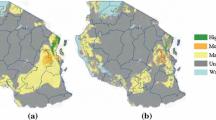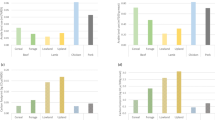Abstract
The components of social costsincluded in the supply analysis are cashoutlays and opportunity costs associated withharvest and alternative residue uses, potentialenvironmental damage that is avoided byexcluding unsuitable land, and costs in movingresidues from farms to processing plants. Regional estimates account for the growingconditions and crops of the main agriculturalareas of the United States. Estimates includethe main U.S. field crops with potential forresidue harvest: corn, wheat, sorghum, oats,barley, rice and cane sugar. The potentialcontribution of residues to U.S. energy needsis discussed.
Similar content being viewed by others
References
Aldrich, S. R., W. O. Scott and E. R. Leng (1978), Modern Crop Production. Champaign, IL: A&L Publications.
Bath, D., J. Dunbar, J. King, S. Berry and S. Olbrich (1998), ‘Byproducts and Unusual Feedstuffs’, Feedstuffs 70, 32-38.
Bressler, R. and R. King (1970), Markets, Prices and Interregional Trade. New York: John Wiley and Sons.
California Energy Commission (1999), Evaluation of Biomass-to-Ethanol Fuel Potential in California: A Report to the Governor and California Environmental Protection Agency (P500-99-022). State of California.
Committee on Beef Cattle Nutrition (1996), Nutrient Requirements of Beef Cattle. National Academy Press.
Committee on Biobased Industrial Products (2000), Biobased Industrial Products: Priorities for Research and Commercialization. Washington, D.C.: National Research Council.
Cross, T. and G. Perry (1995), ‘Depreciation Patterns for Agricultural Machinery’, American Journal of Agricultural Economics 77, 194-204.
Duffy, M. and D. Judd (1994), Estimated Costs of Crop Production in Iowa 1994, FM1712. Ames, Iowa: Iowa State University Extension.
Gale, W. J. and C. A. Cambardella (2000), ‘Carbon Dynamics of Surface Residue-and Root-Derived Organic Matter Under Simulated No-Till’, Soil Science Society of America Journal 64, 190-195.
Gallagher, P. and D. Johnson (1999), ‘Some New Ethanol Technology: Cost Competition and Adoption Effects in the Petroleum Market’, The Energy Journal 89, 89-120.
Hawkins, R. et al. (1995), PLANETOR Users Manual. University of Minnesota, St. Paul: Center for Farm Financial Management.
Hayes, W. A. (1975), Estimating Wind Erosion in the Field, Proceedings of the Soil Conservation Society of America. San Antonio, Texas.
Hoag, D. L. and H. A. Holloway (1991), ‘Farm Production Decisions under Cross and Conservation Compliance’, American Journal of Agricultural Economics 73, 184-193.
Hotelling, H. (1929), ‘Stability in Competition’, Economic Journal 39, 41-57.
Jurgens, M. H. (1993), Animal Feeding and Nutrition. Dubuque, IA: Kendall/Hunt Co.
Khush, G. (1993), ‘Breaking the Yield Frontier in Rice’, Geojouranal, 331-333.
Klingebiel, A. A. and P. H. Montgomery (1961), Land-Capability Classification. Soil Conservation Service, Agriculture Handbook No. 210. Washington, D.C.: U.S. Department of Agriculture.
Larsen, J. B. (1997), ‘Firing Straw for the Production of Electricity with and without Producing District Heating’, in R. P. Overend and E. Chornel, eds., Making a Business From Biomass. Proceedings of a Conference in Montreal. Pergammon Press.
Lazarus, W. (1997), Minnesota Farm Machinery Economic Cost Estimates for 1997. St. Paul, MN: University of Minnesota Extension Service.
Lipinski, E. S., T. A. McClure, J. L. Otis, D. A. Scantland and W. J. Sheppard (1977), Systems Study of Fuels from Sugarcane, Sweet Sorghum, Sugar Beets and Corn, Vol IV. Corn Agriculture. Report No. BMI-1957a(4). Columbus, OH: Battelle Columbus Laboratories.
Park, Y. (1996), Costs of Producing Biomass Crops in Iowa. Ph.D. Dissertation. Ames: Iowa State University.
Paturau, J. M. (1982), By-Products of the Cane Sugar Industry. Amsterdam, Netherlands: Elsevier Co.
Perry, G., B. McCarl, M. Rister and J. Richardson (1989), ‘Modeling Government Program Participation Decisions at the Farm Level,’ American Journal of Agricultural Economics 71, 1011-1020.
Plaster, E. J. (1992), Soil Science & Management. Albany: Delmar Publishing Co.
Reicosky, D. C., S. D. Evans, C. A. Cambardella, R. R. Allmaras, A. R. Wilts and D. R. Huggins (2001), ‘Continuous Corn with Moldboard Tillage: Silage and Fertility Effects on Soil Carbon’, Journal of the Soil and Tillage Research (in review).
Renard, K. G., G. R. Forster, D. K. McCool, G. A. Wessies and D. C. Yoder (1993), RUSLE User's Guide. Ankeny, IA: Soil and Water Conservation Society.
Russell, J. R., M. Brasche and A. M. Cowen (1993), ‘Effects of Grazing Allowance and System on the Use of Corn Crop Residues by Gestating Beef Cows’, Journal of Animal Science 71, 1256-1265.
Shimojo, T. (1979), Economic Analysis of Shipping Freights. Kobe, Japan: Research Institute for Economics and Business Administration, Kobe University.
Skidmore, E. L. and N. P. Woodruff (1968), Wind Erosion Forces in the United States and Their Use in Predicting Soil Loss. Agriculture Handbook No. 346. Washington, D.C.: U.S. Department of Agriculture.
Soil Conservation Service, Kansas (1982), Technical Guide Notice KS-93. Dodge City, KS: U.S. Department of Agriculture.
Soil Conservation Service, Iowa (1987), ‘The Wind Erosion Equation’, Technical Guide Section I-C-2. Des Moines, IA: U.S. Department of Agriculture.
Soil Conservation Service (1991), Conservation Catalog for the 1990's. Des Moines, IA: U.S. Department of Agriculture.
Soil Survey Staff (1996), National Soil Survey Handbook. U.S. Dept. of Agr.-Natural Resources Conservation Service Title 430-VI. Washington, D.C.: U.S. Government Printing Office.
Spelman, C. A. (1994), Nonfood Uses of Agricultural Raw Materials: Economics, Biotechnology and Politics. Wallingford, UK: CAB International.
Stohbehn, D. and G. E. Ayres (1976), Pricing Machine-Harvested Corn Residue. Ames, IA: Iowa State University Extension Service.
U.S. Dept. of Energy (1993), Assessment of Costs and Benefits of Flexible and Alternative Fuel Use in the U.S. Transportation Sector: Technical Report No.11: Evaluation of a Potential Wood-to-Ethanol Process. Washington D.C.: Office of Domestic and International Energy Policy.
Wailes, E. (1999), Farmer Survey of On-Farm Reservoir Investment Study. Fayetteville, AR: Department of Agricultural Economics, University of Arkansas.
Wischmeier, W. H. and D. D. Smith (1978), Predicting Rainfall Erosion Losses-A Guide to Conservation Planning. Agriculture Handbook No. 537. Washington, D.C.: U.S. Department of Agriculture.
Young, M. (1999), ‘Duck Gumbo’, Ducks Unlimited 63, 54-58.
Author information
Authors and Affiliations
Rights and permissions
About this article
Cite this article
Gallagher, P.W., Dikeman, M., Fritz, J. et al. Supply and Social Cost Estimates for Biomass from Crop Residues in the United States. Environ Resource Econ 24, 335–358 (2003). https://doi.org/10.1023/A:1023630823210
Issue Date:
DOI: https://doi.org/10.1023/A:1023630823210




